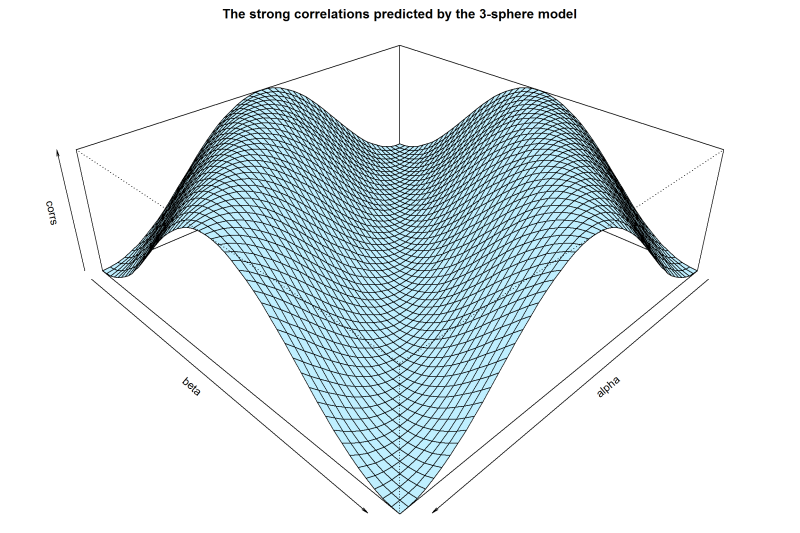Now one of the most important ways of imposing topology on a set -- such as a set of events taking place in a physical space -- is to define the topology in terms of a metric on the set. Such a topology on the set is then called metric topology. Thus we can discuss the origins of quantum correlations in terms of a metric topology.
It turns out that ALL quantum correlations, no matter how complicated, can be understood local-realistically in terms of a metric topology, as correlations among the points of a parallelized (or octonionic) 7-sphere [ cf. the theorem on page 13 of my book linked above ]. For simplicity and definiteness, however, let us concentrate on the simplest quantum correlation, namely the EPR-Bohm or singlet correlation --- i.e., let us try to understand this emblematic correlation locally, in terms of the metric topology of the three-dimensional physical space, without worrying about the higher-dimensional space needed to represent the octonions correctly. But even for this 3D case ( involving the simple rotationally invariant singlet state ) we cannot escape the fact that rotational and spinorial properties of the physical space can be modelled correctly only by using quaternionic numbers. As Grassmann, Hamilton, and Clifford discovered long time ago, ordinary tensors are simply not capable of performing this feat correctly. What is required to model the physical space correctly is a certain combination of scalars and bivectors in the form of unit quaternions. More precisely, we must model the physical space as a set of unit quaternions, which is just a parallelized 3-sphere, or S^3, as described, for example, in this paper.
Now a quaternionic S^3, which is locally (or tangentially) identical to R^3, happens to be "flat" as far as its Riemann curvature is concerned. It is thus quantifiable by the familiar Euclidean metric tensor,
This result follows simply and elegantly because we have correctly used the Clifford-algebraic or quaternionic representation of the 3-sphere to model rotations. But suppose we now insist on using ordinary vectors and the corresponding non-Clifford-algebraic representation of S^3 to model rotations. Can we still derive the strong correlation
It turns out that in that case we can indeed model rotations (or more precisely, their spin values) by means of ordinary vectors and their inner products. The resulting space however has a metric-like structure that is no longer Euclidean -- i.e., it is no longer "flat" in the usual sense, and the role played by torsion within S^3 becomes obscure. In fact, a single Riemannian metric is not capable of modelling this space. An entire spectrum of effective metrics are required to model the rotation or spin values correctly, as originally discovered by Michel Fodje ( although his approach was phenomenological rather than geometrical or topological ). Given two vectors
Here the generalized orthogonality of the vectors
I have explained the detailed relationship between the Clifford-algebraic representation of the 3-sphere and the above effective representation in terms of ordinary vectors in this paper. A further, more direct relationship between the two representations is derived in Eq. (B10) of this paper. It can also be seen explicitly in one of the three different ways the EPR-B correlation has been calculated in this simulation. Let me reproduce here the essential part of the code in the simulation to show the simplicity of the effective representation described above. The measurement functions
- Code: Select all
A = +sign(g(a,e,s)) # Alice's measurement results A(a, e, s) = +/-1 # Here g(u,v,s) is a metric on S^3, reducing to the usual g on R^3
B = -sign(g(b,e,s)) # Bob's measurement results B(b, e, s) = -/+1 # A(a, L) = +/-1 and B(b, L) = +/-1 are exactly as defined by Bell
Cuu = length((A*B)[A > 0 & B > 0]) # Coincidence count of (+,+) events
Cdd = length((A*B)[A < 0 & B < 0]) # Coincidence count of (-,-) events
Cud = length((A*B)[A > 0 & B < 0]) # Coincidence count of (+,-) events
Cdu = length((A*B)[A < 0 & B > 0]) # Coincidence count of (-,+) events
corrs[i,j] = (Cuu + Cdd - Cud - Cdu) / (Cuu + Cdd + Cud + Cdu) # = -a.b
# There are no "0 outcomes" within S^3: Cou = Cod = Cuo = Cdo = Coo = 0
CoB = length(A[g(a,e,s) & A == 0]) # Number of A = 0 events within S^3 (regardless of B events) = 0
CAo = length(B[g(b,e,s) & B == 0]) # Number of B = 0 events within S^3 (regardless of A events) = 0
Finally, I have built this simplified version of the simulation which can be useful for testing the spectacular effects of topology changes when the stochastic parameter
Joy Christian


